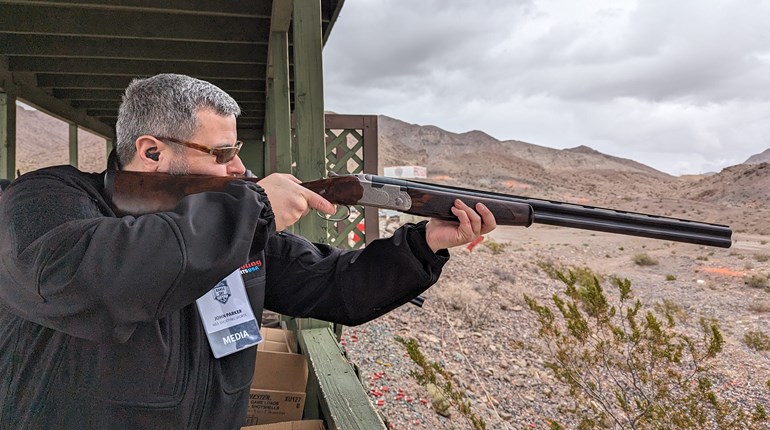If your shotgun, choke and load combination is unproven or suspect, tape a piece of freezer paper to a box then draw a 3-inch circle inside a 10-inch circle in black marker. (The 3-inch circle replicates a turkey’s head.) Better yet, get a turkey head target from Caldwell. Step off 40 yards, take a steady rest and let her rip. Then count the pellet holes in the 3-inch circle.
5 pellets or less: You call that a turkey gun?
Either you are such a turkey master that you shoot a .410-bore and rely on your hen-like mannerisms, or you need to break down and buy a new shotgun because the one you have sucks eggs. Any full-choked 12-gauge with a modern shell should put more than five pellets in a turkey’s head at 40 yards. If the gun is sentimental and you refuse to use anything but it and your old paper-hulled shells, fine, Havilah Babcock, but you better not shoot till you see the hair on his snood. The cheapest remedy is to experiment with various loads. If you are using No. 4, try a 6. If neither covers your target with glory, try 5’s. Try various brands, as some guns’ bore dimensions seem to prefer some wads over others. I’ve had great luck with the Flite Control wad in some Federal Premium loads. It stays with the pellets longer, therefore keeping them together better. Hornady uses the same wad, only called Versatite. Hevi-Shot generally patterns well. And new tungsten-based pellets like Winchester Hi-Density or Federal Heavyweight actually allow you to use a smaller pellet that weighs the same as a larger one, allowing more pellets to strike the target without sacrificing individual pellet energy. The only bad thing is that it would be cheaper to simply buy a Butterball from Safeway.
If changing loads doesn’t work, buy an aftermarket choke tube from Carlson’s, Trulock, Tru-Glo, Primos or others. Many shotgun manufacturers make extra-full chokes. Standard full choke for a 12-gauge is about .693 inch, while some “turkey” chokes are as tight as .665 inch. Just know that it’s not as easy as simply finding a tight choke that will fit your gun’s threads. Again, some barrel/load combinations prefer certain chokes, so it’s a crapshoot whether a new choke tube will dramatically affect your pattern. Likely it will be better than five measly pellets. At any rate, install it then try various loads again. Trial and error is the key.
6-11 pellets: “Congratulations, you are adequate.”
Said no Olympic judge ever. Your gun will kill any turkey on Earth at 40 yards if you aim it in the right place, but typically the pattern will be spotty and will quickly become marginal past 40. Experiment with various loads. Consider a 31/2-inch shell if you are shooting a 23/4- or 3-inch, because despite what sissies say, the more pellets that leave the barrel the more potential there is to place more pellets in a gobbler’s grill. In general, lower velocity shells pattern better than high velocity. Lastly, if after several shots you notice the pattern is actually denser in other places than the 3-inch circle, try buying sights or mounting a scope on your shotgun. I know it sounds blasphemous, but your problem may not be in patterning but in point-of-aim/point-of-impact issues. If an optic doesn’t work, try the aforementioned remedies. If you’re happily married to mediocrity, just keep it inside 40 yards, mister.
12-24 pellets: Bona fide turkey gun
Don’t do anything to this rig other than place it high on the mantel to keep your kids’ grubby hooks off it. Buy a bunch of the shells that produced these rich patterns, because you never know when an ammo company will discontinue that particular load for something “new and improved.” You don’t need any better; what you need is more time to hunt turkeys. If you are a perfectionist who wants to win the world turkey shoot championship, the best option is to give it to a shotgun choke specialist and have him back-bore it, put a scope on it and then handload shells, because as the beer commercial goes, “It doesn’t get much better than this, boys.” So save your money to buy something nice, like a guest house for your mother-in-law.
25 pellets or more: Turkey Shoot Gold
This gun practically sends each pellet through a turnstile before letting it loose. It’s a rifle in a shotgun’s physique. It’s a rig fit for a turkey shoot. After you shoot a turkey at 65 yards and drop it like the “Huffington Post,” go ahead and enter the National Wild Turkey Federation’s Still Target Championship, which awards shooters for the tightest turkey load patterns. While the record is 54, generally a pellet count in the low 30s wins it. But I caution against hunting with patterns that are too tight. It’s like the championship duck caller who can’t call real ducks: A real turkey bobs and weaves like Muhammad Ali in his heyday, and therefore a pattern that’s too tight can result in misses if the shooter isn’t perfect with his placement. Turkey Shoot Gold patterns look good on paper, but they can appear rather thin as your hard-won gobbler is running away from your hot skillet.




































